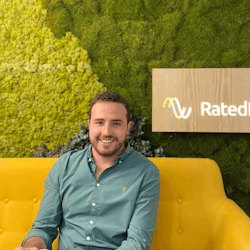- Solar energy blog
- How RatedPower can help you to finance your PV projects
How RatedPower can help you to finance your PV projects
Financing a new solar photovoltaic project takes time and effort, and there are many variables to consider. In this blog, we’ll look at the steps involved in planning and financing a new PV installation, as well as how RatedPower can help you plan your finances and acquire investment.


Bernardino Martin
Product Owner
Bernardino brings over two years of expertise to RatedPower, serving as Product Owner in the Product department. Previously excelling as a Customer Success Manager focusing on diverse markets where he developed a keen understanding of those market needs. Leveraging this experience, he now serves as a dedicated Product Owner, enhancing software solutions. Holding a Degree in Energy Engineering and a Master's in Industrial Engineering, Bernardino seamlessly combines technical prowess with a customer-centric approach, contributing to the ongoing innovation and advancement of renewable energy solutions.

Content
Financing a new solar photovoltaic (PV) project can take time and effort. Not only is a great deal of capital required to get solar installation projects of any size off of the ground, but there are also many variables to consider.
In this blog, we’ll look at the steps involved in planning and financing a new PV installation, as well as how RatedPower can help you plan your finances and acquire investment.
Solar project lifecycle
From inception to opening, a new PV installation can take anywhere from 3 to 15 years to complete. The lifecycle of a typical PV project will play out in the following steps.
Site identification/concept — Potential sites will be surveyed and identified, along with the creation of a rough concept. Funding will be acquired for project development
Pre-feasibility study — Assessment of different technical options and the market, as well as approximate costs and any permitting requirements
Feasibility study — Assessment of preferred option and financing options, including initiation of permitting process and first contact with banks
Financing/contracts — Financing for the project is put into place, and major contracts negotiated
Detailed design — Detailed design and project implementation schedule finalized. Permitting process and loans completed
Construction — The longest step. Infrastructure constructed and equipment bought and installed
Commissioning — Preparing and testing the new installation prior to operation
Operation — The installation is opened and producing energy
With the above framework, we can see, in broad strokes, the lifecycle of a new PV project. Now that we have this in place, let’s look at how a project like this is financed.

Financing a new PV project
The creation of a new PV project starts with a sponsor/developer who is responsible for planning and pitching the project.
First, the sponsor sets up a ring-fenced, limited liability company through which the project is run. Setting up a separate entity protects the sponsor from anything that might go wrong with the project. Any issues with the project, financing, permitting, etc., are mediated through the limited liability company, therefore keeping the sponsor at arms’ length.
Once this company is in place, they have to negotiate with banks and investors to secure financing for the project and conclude necessary agreements. Typically, this will come in the form of equity investment from the sponsor and bank loans. On average, there will be a 20/80 split between investment from the sponsor and loans. With the investment in place, the project can get underway.
When all the agreements are complete, and the debt and equity financing are available to be drawn down to fund the project, this stage is known as the financial close. The money will then be passed to contractors to cover the construction and permitting costs associated with the project. Once finished, the installation can become operational and start generating energy through the grid.
The project company would then sell the energy to the off-taker/energy buyer under a PPA agreement. The PPA agreement is the primary method of securing a steady stream of long-term revenue for the new installation. This revenue can then be used for the installation’s operation and maintenance (O&M) costs.
When the O&M costs are taken care of, excess revenue can be used to pay back bank loans and interest. It can also be diverted to the sponsor to cover their initial investment and realize profits.
This all seems relatively straightforward, but in order to acquire bank loans and investments, the sponsor must prove that the company can pay off the loans and interest through sufficient revenue generation. The ring-fenced company is based on cash-flow financing, so accurate revenue predictions are crucial for ensuring investment.
To do this, the sponsor requires robust energy generation prediction tools so that they can prove the project will be a success. This is where a platform like RatedPower can help.

How RatedPower can help with the financing of new PV projects
RatedPower is a cloud-based, end-to-end software solution that can help with the study, analysis, design, and engineering of PV plants through automation and optimization. Having a tool like us can streamline large-scale solar PV projects' design and engineering processes and help secure investment and financing.
A new PV project lives and dies on whether it can generate enough energy to repay any loans and investment needed in its planning, construction, and operation phases. RatedPower is able to provide highly accurate energy estimates to predict if a project will produce the required amount of energy upon completion.
Energy yield reports consider many variables, such as gains, losses, weather conditions, nighttime consumption, etc. Additionally, the platform can provide estimates at different levels of certainty from P50 - P99 to model for both best- and worst-case scenarios.
RatedPower also has a built-in CAPEX template tool, allowing you to generate specific, accurate CAPEX projections. Many templates are available, with the option to design your own to the specifications of each project. This tool can estimate the total investment needed from bank and equity investors.
RatedPower can generate financial reports based on these models, showing CAPEX, repayments, tax payments, and any other required financial information. On top of this, the platform can generate agreement reports, such as interconnection facility reports, overhead line reports, and substation reports.
With all of this information in place, the sponsor can determine exactly how much investment they need, if this investment can be paid back once the project is completed, the operating costs of the completed project, and how long it will take to pay back any loans and investments.
They can then take this information to potential investors and banks and make a stronger case for why investment in their project is a good idea, thus significantly increasing the chances of acquiring the financing they need. With a robust financial modeling tool like RatedPower, sponsors, developers, and investors are working from complete information, and a new PV project is more likely to get off the ground.

To learn more about how RatedPower can help you with your next PV project, get in touch with the team today!
Latest stories
Related posts
Technology and engineering
Outsmarting congestion: How efficient solar design helps navigate Nordic grid limits
Learn how Nordic operators and solar developers are adjusting to tighter grid conditions and how policy and design decisions are keeping projects on track.
Updated 16 DEC, 25

Technology and engineering
The rise of ultra-thin perovskite solar cells
Learn about Japan’s $1.5B initiative to commercialize ultra-thin, flexible perovskite solar cells and how it could transform the solar landscape globally.
Updated 30 SEP, 25

Technology and engineering
The green hydrogen boom in LatAm
Latin America is emerging as a green hydrogen leader. Learn how LatAm countries are leveraging solar and wind power to drive green hydrogen production.
Updated 22 JUL, 25

- RatedPower
- Solar energy blog
- How RatedPower can help you to finance your PV projects
 Watch a demo
Watch a demo Ask our AI Product Expert
Ask our AI Product Expert

